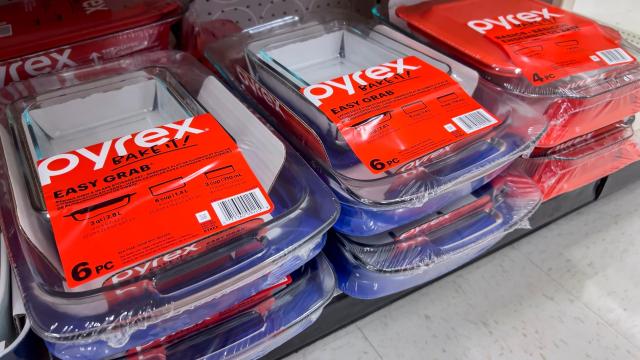Everyone loves a good kitchen hack, and one of the most popular examples concerns glass cookware. Between Twitter, Reddit, and TikTok, there are hundreds of posts asserting that all-caps PYREX is the good stuff (aka, borosilicate glass), and all-lowercase pyrex is junk (aka, tempered soda-lime glass). If you stick to PYREX-branded products, the reasoning goes, you won’t have to worry about your casseroles exploding all over your kitchen, possibly maiming you and your loved ones in the process.
This kind of hack is primed to go viral: It deals with a high-stakes home safety issue, it feels a little conspiratorial, and it immediately clicks with pretty much anyone who’s set foot in a kitchen before. Unfortunately, it’s also horseshit. You can’t tell what material your glass cookware is made of by looking at the brand name, and if you read the citations that supposedly prove you can, you’d know why.
Everyone links to the Wikipedia article for Pyrex as proof that the all-caps brand is better, but when you actually read the text of the article, it’s not that simple. Corning Inc. filed the original U.S. trademark — PYREX in all caps — in 1915, at which time they were exclusively manufacturing borosilicate glass products. The company introduced the all-lowercase trademark in 1975, about 20 years after the brand had already started experimenting with tempered soda-lime glass in its products. This means that PYREX branded soda-lime products are out there, a fact the Wikipedia article explicitly confirms:
“Both trademarks, PYREX (all uppercase) and pyrex (all lowercase, introduced in 1975 [1]), were used interchangeably in the marketing of kitchenware products made of both borosilicate and soda lime glass, [2] in addition to related accessories, for several decades.”
If you buy vintage PYREX manufactured before 1975, it could be borosilicate — but it also could be tempered soda-lime. Anything made for “several decades” after 1975 could fall into any of the four possible permutations of material and brand because Corning, Inc. used the two brands interchangeably and doesn’t have to indicate what their products are made of.
So, how can you actually tell if you’re dealing with “real” Pyrex? As a rule of thumb, it’s safe to simply assume you aren’t — at least, not if you’re in the United States. The “real stuff” hasn’t existed at all in the U.S. market for at least 30 years. Pyrex started phasing out borosilicate glass in the 1950s and had stopped using it entirely by 1998, when World Kitchen (now Corelle Brands) bought the licence to the PYREX and pyrex brands. Unless you buy your cookware from a vintage shop that can prove it was manufactured in the 1940s or earlier, you’re very unlikely to come across borosilicate glass pyrex.
That doesn’t mean you can’t get borosilicate cookware — it just means you can’t get it with the pyrex brand. As Reddit user Giant_Meteor_2024 points out in a 2018 thread about PYREX branding, laboratory glassware is made of borosilicate glass: “If you don’t mind microwaving a 500ml beaker instead of a fancy PYREX thing, they can be found on the cheap.” (You might not be able to find a laboratory-grade casserole dish, though.)
If you’ve read a few exploding-pyrex horror stories, you may not be exactly stoked about using tempered soda-lime glass — and honestly, fair enough. But it’s not inherently dangerous; it only becomes so when it’s exposed to sudden, direct, and highly localised changes in temperature. To give you an example of what that means, in college, my friends and I managed to blow up a pyrex pan of mac and cheese because we left it sitting on the stove next to — but not on — an electric coil burner. One of us decided she wanted coffee, turned on the burner under the kettle, and came back to the living room. A few minutes later, we heard a loud bang and went to the kitchen, where crime scene littered with shattered pyrex and mac and cheese awaited us. Being right next to a hot electric burner was too much of a temperature shock for the glass, and it went boom.
That’s the kind of situation you have to avoid when cooking with soda-lime glass. Putting a pyrex dish that was just in the fridge or freezer into a preheated oven on a rack is fine; putting it directly on a preheated pizza stone, sheet pan, or baking steel is absolutely not. Similarly, putting a hot pyrex pan on a very cold and/or wet surface is a bad idea, as is pouring boiling water directly into it. But if you avoid extreme temperature shocks, it’s fine to use. It’s been 15 years since my brush with exploding pyrex, and I still use it on a daily basis.

Leave a Reply
You must be logged in to post a comment.